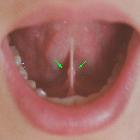Kimura disease
Kimura disease, also known as eosinophilic hyperplastic lymphogranuloma, is a rare benign inflammatory disease that characteristically manifests as enlargement of cervical lymph nodes and salivary glands.
Epidemiology
Kimura disease typically affects males (80%) between 20 and 40 years of age (80% of cases) , and is most frequently seen in Asia. Sporadic cases are seen in other geographic regions, however these are uncommon. An infectious agent is presumed to be the cause of an immunological response, however no specific pathogen has as yet been identified .
Clinical presentation
Presentation is with subcutanous masses and enlargement of the lymph nodes of the head and neck, particularly near the angle of the mandible and post-auricular groups. Salivary glands (particularly the parotid and submandibular glands) and lymph nodes of the axilla, groin, popliteal fossa, medial epicondyle and elsewhere may also be involved . They are usually not painful. Involvement of adjacent soft tissues is uncommon, although direct extension into the pinna of the ear has been described.
These changes are usually associated with eosinophilia in the peripheral blood and in tissues, and marked increase in serum levels of immunoglobulin E (IgE) .
There have been case reports of eosinophillic panniculitis in patients with Kimura disease and some authors have reported presentations with nephrotic syndrome.
Pathology
Histologically Kimura disease is characterized by:
- proliferation of lymphoid follicles
- cellular infiltrates
- eosinophils (majority), sometimes progressing to eosinophilic abscesses
- also plasma cells lymphocytes, and mast cells
- vascular proliferation of post-capillary venules
- fibrosis
Peripheral eosinophilia is common.
Radiographic features
Ultrasound
Ultrasound is a useful modality for assessment of the neck and to aid in biopsy.
Sonographic features include :
- solid, enlarged nodes sometimes maintaining hilar architecture
- hypoechoic, usually homogeneous: ~90%
- foci of necrosis uncommon: ~15%
- increased vascularity usually in a hilar distribution: ~90%
- salivary glands also hypoechoic, but usually more heterogeneous
CT
CT demonstrates nonspecific appearances of
- markedly enlarged cervical nodes +/- parotid and submandibular glands
- intense enhancement of nodes
- heterogenous enhancement of salivary glands
MRI
MRI signal intensity and enhancement varies depending on the amount of fibrosis and vascular proliferation present .
- T1: hypointense or isointense compared with salivary tissue
- T2
- typically hyperintense compared to salivary gland tissue
- variable according to degree fibrosis
- T1 C+ (Gd): usually homogeneous enhancement
Treatment and prognosis
Kimura disease is benign, and no firmly established treatment protocols have been described. Options include :
- conservative management
- radiotherapy
- steroid and oxyphenbutazone (with only transient improvement)
- resection
- cyclosporine
Recurrence rate is high for steroids and surgery, and as such radiotherapy is favored by some authors , although as the condition is benign and patients are young, not all agree . There were seven patients reportedly cured with cyclosporine (8).
History and etymology
It was first described in China by Kim and Szeto in 1937 as eosinophilic hyperplastic lymphgranuloma . It was then described in 1948 by Kimura et al. in Japan .
Differential diagnosis
Differential diagnosis on imaging is that of lymph node enlargement, and includes:
- benign reactive nodes / infectious mononucleosis / drug reactions
- nodal metastases
- lymphoma/leukemia
- tuberculous adenitis
- Kikuchi-Fujimoto disease
- Castleman disease
- parasitic infections
Histologically Kimura disease was initially thought to be related to angiolymphoid hyperplasia with eosinophilia (ALHE), however clinically and radiologically these two entities are clearly different:
- ALHE affects primarily female Caucasians
- ALHE involves dermis without lymph node enlargement
Siehe auch:
- Lymphom
- Morbus Castleman
- Glandula submandibularis
- tuberkulöse Halslymphknoten
- Kikuchi-Fujimoto disease
- Lymphadenopathie
und weiter:

 Assoziationen und Differentialdiagnosen zu Kimura disease:
Assoziationen und Differentialdiagnosen zu Kimura disease:



